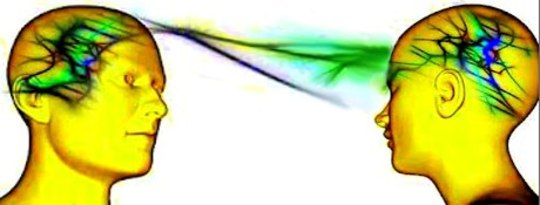
Present a material scientist the problem of explaining how the mind recreates a part of nature’s scenery in a hallucination, and he discusses the complexities of the human brain. He knows hallucinations are possible. But ask the scientist how two minds communicate without speaking, or come to share in the same dream or hallucination, and he will measure you for a straitjacket.
Material scientists have no place in their theories for telepathy because in their worldview the minds of two people cannot talk to each other. Events such as the following, recounted in Phantasms of the Living, cannot occur in material science’s world:
Colonel Lyttleton Annesley . . . was staying in my house some time ago, and one afternoon, having nothing to do, we wandered into a large unoccupied room. . . . Colonel A. was at one end of this long room reading, to the best of my recollection, while I opened a box, long forgotten, to see what it contained.
I took out a number of papers and old music, which I was turning over in my hand, when I came across a song in which I, years before, had been accustomed to take a part, “Dal tuo stellato soglio,” out of “Mose in Egitto,” if I remember right. As I looked at this old song, Colonel A., who had been paying no attention whatever to my proceedings, began to hum, “Dal tuo stellato soglio.” In much astonishment I asked him why he was singing that particular air. He did not know. He did not remember to have sung it before; indeed I have not ever heard Colonel A. sing. . . .
I told him that I was holding the very song in my hand. He was as much astonished as I had been, and had no knowledge that I had any music in my hand at all. I had not spoken to him, nor had I hummed the air, or given him any sign that I was looking over music. The incident is curious, for it is outside all explanation on the theory of coincidence.
Minds Talk To Each Other
Minds are not supposed to talk to each other, according to material science, yet they do. Often the shared thought is as simple as the song on our mind, where to eat dinner, or what to buy a friend for a birthday. We all have them but pay little attention.
For example, in reading the book His Excellency by Joseph Ellis I came across the word “ukase,” which I had never heard or read. The next day, in taking the elevator to work, I noticed a “word of the day feature” on the elevator information screen: the word of the day was “ukase,” a Russian word meaning a government directive.
Material science has no place in its worldview for these events. Because it detaches mind from matter, it must treat coincidences between two events, such as Colonel Annesley humming the song his friend was reading, as statistically independent, like two separately spun number wheels. This approach makes coincidences mathematically possible, but it hardly accounts for those occasions when coincidences pile on top of each other, and the related events seem to flow from one script. In these unique moments we find scientific instruments incapable of drawing a full picture of the world we experience.
Carl Jung and Synchronicity
 In 1952 psychologist Carl Jung published a paper titled “Synchronicity” that analyzed these oddities of life and attributed them to the workings of an unconscious mind. One story in his paper is taken from a collection by Camille Flammarion and concerns a certain M. Deschamps who, when a young boy in Orleans, was given a piece of plum pudding by M. de Fortgibu. While in a Paris restaurant ten years later M. Deschamps saw plum pudding on the menu and ordered it. Unfortunately, the last plum pudding had already been ordered by none other than M. de Fortgibu, who happened to be in the same restaurant.
In 1952 psychologist Carl Jung published a paper titled “Synchronicity” that analyzed these oddities of life and attributed them to the workings of an unconscious mind. One story in his paper is taken from a collection by Camille Flammarion and concerns a certain M. Deschamps who, when a young boy in Orleans, was given a piece of plum pudding by M. de Fortgibu. While in a Paris restaurant ten years later M. Deschamps saw plum pudding on the menu and ordered it. Unfortunately, the last plum pudding had already been ordered by none other than M. de Fortgibu, who happened to be in the same restaurant.
A good many years later, our hero, M. Deschamps, was invited to share in a plum pudding as a rare treat. As he was eating it, he commented that the only touch missing was the presence of M. de Fortgibu. Just at that moment the door opened and an elderly gentleman walked in; it was none other than M. de Fortigbu. He had apparently gotten the wrong address and mistakenly walked in on the party.
Another story Mr. Jung relates is from a collection compiled by Wilhelm von Scholz concerning odd lost-and-found cases. In this story, a mother took a picture of her son in Germany’s Black Forest. She then brought the film to Strasburg to be developed, but shortly thereafter World War I began and she was unable to pick up the developed photographs. Two years later the mother, intending to photograph her daughter, purchased film in Frankfurt. But she found the film oddly double-exposed: underneath the new film was the picture she took of her son in 1914. [Incredible Coincidences, Alan Vaughn].
Coincidences: Freakish Events or Unfolding Drama?
In the eyes of the material scientist, these intriguing coincidences are freakish events of no importance in their mechanical world; in a dream world they are the rule, not the exception. They show the dream of God unfolding with meaning, intrigue, and even humor. In an evolving dream world, for events to seem connected and reveal meaning should not appear unusual. During special moments we sense an overriding purpose to life, some connecting theme holding us together, a script written in our souls that we follow without knowing why. On these occasions, life shows it has a hidden story line, an unfolding drama of its own.
But in highlighting these minor coincidences of life, we may tend to overlook coincidences of a much grander variety. May not it seem coincidental, for instance, that we today rest on a planet balanced perfectly in the midst of a universe of stars, the lucky beneficiaries of natural forces all nicely programmed to make life possible and the future predictable? Is it not coincidental the way earth’s life-forms all seem adapted to their environments, like glove in hand? Can male and female imagine better mates?
We can thus raise the stakes when analyzing life’s coincidences. Plum puddings, lost rings, and repeating themes play a small part in this story. Looking out at the world we may ask: Are we just coincidentally synchronized with the universe, or has indeed the world evolved as one dream?
©2013, 2014 by Philip Comella. All Rights Reserved.
Reprinted with permission. Publisher: Rainbow Ridge Books.
This article was adapted with permission from:
The Collapse of Materialism: Visions of Science, Dreams of God
by Philip Comella.
 “Philip Comella, takes a fresh and bold look at the debate between science and religion—and attempts to go farther than any other book to unite them. For years, we have been led to believe that the universe traces its roots back to the Big Bang. Suppose, though, that the cosmos wasn’t, in fact, borne of a random eruption—but rather stems from the ever-evolving imagination of a multi-dimensional dreaming mind? Such a drastically different perspective would no doubt change the way we see not only ourselves, but also our place in the infinite realm of the universe. Such is the central premise of The Collapse of Materialism. Probing, well written, and thoroughly researched, and bolstered by a wide range of enlightening sources, including religion, eastern philosophy—and science itself—this book breaks important ground regarding the limited purview of life as we’ve come to know it, encouraging readers to explore the unfettered depths of a new vision of universal purpose.”—Dominique Sessons, Apex Reviews
“Philip Comella, takes a fresh and bold look at the debate between science and religion—and attempts to go farther than any other book to unite them. For years, we have been led to believe that the universe traces its roots back to the Big Bang. Suppose, though, that the cosmos wasn’t, in fact, borne of a random eruption—but rather stems from the ever-evolving imagination of a multi-dimensional dreaming mind? Such a drastically different perspective would no doubt change the way we see not only ourselves, but also our place in the infinite realm of the universe. Such is the central premise of The Collapse of Materialism. Probing, well written, and thoroughly researched, and bolstered by a wide range of enlightening sources, including religion, eastern philosophy—and science itself—this book breaks important ground regarding the limited purview of life as we’ve come to know it, encouraging readers to explore the unfettered depths of a new vision of universal purpose.”—Dominique Sessons, Apex Reviews
Click here for more info and/or to order this book on Amazon.
About the Author
 PHILIP COMELLA is a practicing lawyer with a philosophy degree whose mission in life is to expose the fallacies in our current materialistic worldview and to advance a more promising—and rational—outlook. In pursuit of that mission, he spent 30 years studying the foundational ideas to our current scientific worldview and developing the arguments made in this book.
PHILIP COMELLA is a practicing lawyer with a philosophy degree whose mission in life is to expose the fallacies in our current materialistic worldview and to advance a more promising—and rational—outlook. In pursuit of that mission, he spent 30 years studying the foundational ideas to our current scientific worldview and developing the arguments made in this book.
Additional articles by this author.


























